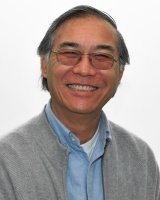Dr. Liguang Tang
Position: Professor
Educational Background: B.A. 1977, Beijing Polytech. University, Beijing, China M.S. 1981, Institute of High Energy Physics, the Chinese Academy of Science & Technology, Beijing, China PhD 1987, University of Houston, Houston, TX
Research Interests: Experimental Hypernuclear Physics at JLAB
I am an experimental nuclear physicist with a joint position both as faculty at HU and as staff scientist at the Thomas Jefferson National Accelerator Facility (JLAB) – which is located about 14 miles from the HU campus. My research primarily focuses on the experimental programs established at JLAB using continuous wave electron beam CEBAF. In addition, I am also in close collaboration with physicists at other facilities using different probes or technique, such as experiments at J-PARC in Japan and electron beam at Mainz in Germany.
Our group is the leading group in the nation in the area of experimental hypernuclear physics – a sub field in nuclear physics, with leadership (Spokesperson/co-Spokesperson) role on all hypernuclear experiments (E89-009, E01-011, E02-017, E05-115/E08-002) carried out in Hall C or (E08-012/PR10-001) to be conducted in Hall A at CEBAF. These experiments measures mass spectroscopy, lifetime, and single particle binding energy with the highest possible precision made possible by the CEBAF beam at JLAB and the dedicated high precision spectrometer system and equipment built and continuously upgraded for such research investigations. The measurement is realized by converting a proton in the nucleus into a L particle – a hyperon in the same baryonic family with proton but with different quark content (strangeness) – and observing the characteristics of the resulted hypernuclei. The goal is to provide precise information needed to understand the Hyperon-nucleon interactions which cannot be learned by other means. This study will allow us to extend our knowledge on baryonic strong interaction beyond nucleon-nucleon interaction with additional quark degree of freedom and to obtain the unified theory on baryonic interactions. On the other hand, the imbedded L particle serves as excellent probe to study the interior nuclear structures, changes due to L insertion, or changes of L in the strongly interactive nuclear matter. These studies also provide important knowledge toward understanding the building mechanism of the unknown universe such as the mass and density of neutron stars.
Selected Publications:
- Tang, New Era: Study Light Hypernuclei via Two Body Decay Pion Spectroscopy using CEBAF Beam, proceedings of the Sendai International Symposium, Strangeness in Nuclear and Hadronic Systems (SENDAI08), Sendai, Japan, December 14-18, 2008, World Scientific, Edited by K. Maeda, S.N. Nakamura, H. Tamura and O. Hashimoto, Page 346.
- Tang, et al., The HKS experiment on L-hypernuclear spectroscopy via electroproduction at Jlab, Nuclear Physics A, Vol. 790, 9 June 15, 2007, Page 679c-682c.
- Ukai, et al., Observation of the 7MeV excited spin-flip and non-spin-flip partners in 16LO by g-ray spectroscopy, The European Physical Journal A – Hadrons and Nuclei, Vol. 33, No. 3, 247-250 (2007)
- Yuan, et al., Hypernuclear spectroscopy using the (e,e’K+) reaction, Phys. Rev. C, Vol. 73, 044607 (2006)
- Ukai, et al., Cascade g decay in the 7LLi hypernucleus, Phys. Rev. C, Vol. 73, 012501(R), 2006
- Tang, High precision spectroscopy of L-hypernuclei beyond p-shell using electromagnetic probes at JLAB, selected papers presented at the 2nd Intgernational Conference on Nuclear and Particle Physics with CEBAF at Jefferson Lab, Dubrovnik, Croatia, 26-31 May 2003, edited by , published by the Croatian Physics Society, special issue: Fizika B (Zagreb) Volume 13, No. 1, 2004
- Sasao, et al. 7LLi ground-state spin determined by the yield of ? rays subsequent to weak decay, Phys. Lett. B579 (2004) 258-264
- Miyoshi, et al. High Resolution Spectroscopy of the 12LB Hpernucleus Produced by the (e,e’K+) Reaction, Phys. Rev. Lett. Vol.90 , No.23, 232502, 2003
- Tang, First Experiment to Produce Λ-hypernuclei Using Electron Beam At JLAB, World Scientific, Modern Physics Letters A, Vol. 18, Nos. 2-6 (2003) 112-115
- Miyoshi, et al., A silicon strip detector used as a high rate focal plane sensor for electrons in a magnetic spectrometer, Nucl. Instr. and Meth., A496 (2003) 362-372
J.K. Ahn, et al., Production of ΛΛ4H Hypernuclei, Phys. Rev. Lett. Vol.87 , No.13 (2001).
- Ajimura, et al., Observation of Spin-orbit Splitting in L Single-particle States, Phys. Rev. Lett. Vol.86 , No.19 (2001)4255-4258


